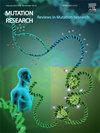Targeting cancer-cell mitochondria using Tigecycline improves radiotherapy response in colorectal cancer cell line
IF 1.5
4区 医学
Q4 BIOTECHNOLOGY & APPLIED MICROBIOLOGY
Mutation Research-Fundamental and Molecular Mechanisms of Mutagenesis
Pub Date : 2025-01-01
DOI:10.1016/j.mrfmmm.2025.111905
引用次数: 0
Abstract
Background
Colorectal cancer (CRC) is the third most common cancer worldwide and causes more than 50,000 deaths in the United States each year. Due to the limited therapeutic options and poor prognosis in CRC, extensive research and development of novel therapeutic methods is essential. In this regard, the presence of cancer stem cells with unlimited division ability is the main reason for the therapeutic resistance in CRC. Tigecycline is a pharmacological mitochondria inhibitor and blocks mitochondria-related cell proliferation in cancer cells. This study investigated the effects of Tigecycline combined with radiotherapy on CRC cell apoptosis.
Methods
Human colorectal cancer cells (HCT-116) were treated with Tigecycline, and cell viability was measured with MTT assay. In the next step, the cells were exposed to radiation using a Siemens Primus 6 MV linear accelerator at radiation dose of 400 cGy. Finally, we evaluated cancer cell apoptosis, caspase-3 activity and apoptotic-related genes expression with AnnexinV/PI, flowcytometry and gene expression, respectively.
Results
The MTT assay revealed an IC50 value of 93 μM for Tigecycline after 48 hours. Mitochondria inhibition, at its IC50 value, sensitizes colorectal cancer cells to radiotherapy. Compared to monotherapy, the combination therapy increased the number of apoptotic cells and caspase-3 activity, up-regulated pro-apoptotic genes, and down-regulated anti-apoptotic genes.
Conclusion
In conclusion, our data suggests that targeting mitochondria may represent a clinically relevant approach to enhance the sensitivity of colorectal cancer cells to therapy. These findings could provide new insights into cancer therapy and might be used as a novel method to improve the current state of CRC therapy.
替加环素靶向肿瘤细胞线粒体改善结直肠癌细胞系放疗反应
结直肠癌(CRC)是全球第三大常见癌症,每年在美国导致超过5万人死亡。由于结直肠癌的治疗选择有限,预后差,因此广泛研究和开发新的治疗方法至关重要。因此,具有无限分裂能力的肿瘤干细胞的存在是导致结直肠癌耐药的主要原因。替加环素是一种药理线粒体抑制剂,可阻断癌细胞中线粒体相关细胞的增殖。本研究探讨替加环素联合放疗对结直肠癌细胞凋亡的影响。方法替加环素处理人结直肠癌细胞(HCT-116),采用MTT法测定细胞活力。下一步,使用西门子Primus 6 MV线性加速器将细胞暴露在400 cGy的辐射剂量下。最后,我们分别用AnnexinV/PI、流式细胞术和基因表达法检测肿瘤细胞凋亡、caspase-3活性和凋亡相关基因的表达。结果MTT检测显示替加环素作用48 小时后的IC50值为93 μM。线粒体抑制,在其IC50值下,使结直肠癌细胞对放疗敏感。与单药治疗相比,联合治疗增加了凋亡细胞数量和caspase-3活性,上调了促凋亡基因,下调了抗凋亡基因。总之,我们的数据表明,靶向线粒体可能是提高结直肠癌细胞对治疗敏感性的临床相关方法。这些发现可能为癌症治疗提供新的见解,并可能作为改善CRC治疗现状的新方法。
本文章由计算机程序翻译,如有差异,请以英文原文为准。
求助全文
约1分钟内获得全文
求助全文
来源期刊
CiteScore
4.90
自引率
0.00%
发文量
24
审稿时长
51 days
期刊介绍:
Mutation Research (MR) provides a platform for publishing all aspects of DNA mutations and epimutations, from basic evolutionary aspects to translational applications in genetic and epigenetic diagnostics and therapy. Mutations are defined as all possible alterations in DNA sequence and sequence organization, from point mutations to genome structural variation, chromosomal aberrations and aneuploidy. Epimutations are defined as alterations in the epigenome, i.e., changes in DNA methylation, histone modification and small regulatory RNAs.
MR publishes articles in the following areas:
Of special interest are basic mechanisms through which DNA damage and mutations impact development and differentiation, stem cell biology and cell fate in general, including various forms of cell death and cellular senescence.
The study of genome instability in human molecular epidemiology and in relation to complex phenotypes, such as human disease, is considered a growing area of importance.
Mechanisms of (epi)mutation induction, for example, during DNA repair, replication or recombination; novel methods of (epi)mutation detection, with a focus on ultra-high-throughput sequencing.
Landscape of somatic mutations and epimutations in cancer and aging.
Role of de novo mutations in human disease and aging; mutations in population genomics.
Interactions between mutations and epimutations.
The role of epimutations in chromatin structure and function.
Mitochondrial DNA mutations and their consequences in terms of human disease and aging.
Novel ways to generate mutations and epimutations in cell lines and animal models.

 求助内容:
求助内容: 应助结果提醒方式:
应助结果提醒方式:


